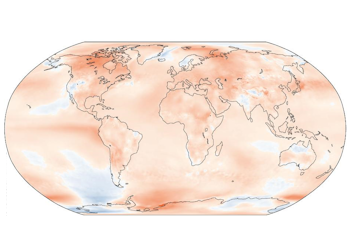December the Warmest Month on the Globe
 2024-01-18 (IPMA)
2024-01-18 (IPMA)
December 2023 was the hottest month ever recorded globally, with an average global temperature of 13.51°C, 0.85°C above the 1991-2020 average (Fig. 1). The month is estimated to have been about 1.78°C warmer than the pre-industrial average of 1850-1900.
In Europe, the average air temperature was +0.97°C higher than the 1991-2020 average. There was a significant contrast in temperatures across Europe in December. Warmer-than-average conditions, relative to the 1991-2020 normal, were observed in a northwest-southeast region, from the United Kingdom and Ireland (the UK experienced its warmest Christmas Eve in the last 26 years) to Turkey and the Caucasus, where Armenia recorded its warmest December in 100 years. Record daily temperatures were also reported in Spain in mid-December. On the other hand, a large part of the Nordic countries experienced colder-than-average conditions for the third consecutive month. In Sweden, some regions recorded daily average temperatures 10°C below the usual. These cold conditions also extended to northwest Russia and central Greenland.
Regarding precipitation, much of Europe experienced wetter-than-average conditions, with several storms affecting central and northwest Europe, leading to widespread snow and floods. Scandinavia, Iceland, and southern Europe reported drier-than-average conditions.
In mailand Portugal, December 2023 had normal air temperatures and was very dry in terms of precipitation (Fig. 2). The average air temperature of 9.99°C was above normal with an anomaly of +0.18°C.
The average maximum air temperature, 14.25°C, was above normal with an anomaly of +0.51°C, while the average minimum air temperature, 5.72°C, was below normal with an anomaly of -0.16°C.
Throughout the month, there was some variability in air temperature values (minimum, average, and maximum), with notable periods from December 7 to 12 with temperatures well above the monthly average, especially the minimum, and from December 14 to 27 with consecutive below-average minimum temperatures.
In terms of precipitation, it was the 7th driest December since 2000, with a total of 58.5 mm, corresponding to 44% of the 1981-2010 average value. Precipitation occurred in the first half of the month and in the last days of the month, especially in the Northern and Central regions, with persistent and sometimes heavy precipitation, especially in Minho and Douro Litoral.
At the end of the month, there was an increase in the area and intensity of weak meteorological drought in the southern region, with districts of Setúbal, Beja, and Faro experiencing moderate drought. On December 31, 38% of the territory was in meteorological drought.
Imagens associadas

Figure 1: Surface air temperature anomaly in December 2023 compared to the climatological normal 1991–2020. Source: Copernicus Climate Change Service/ECMWF

Figure 2: Anomaly of average air temperature and percentage of precipitation in December (period 1941 – 2023) compared to the 1981-2010 average.
